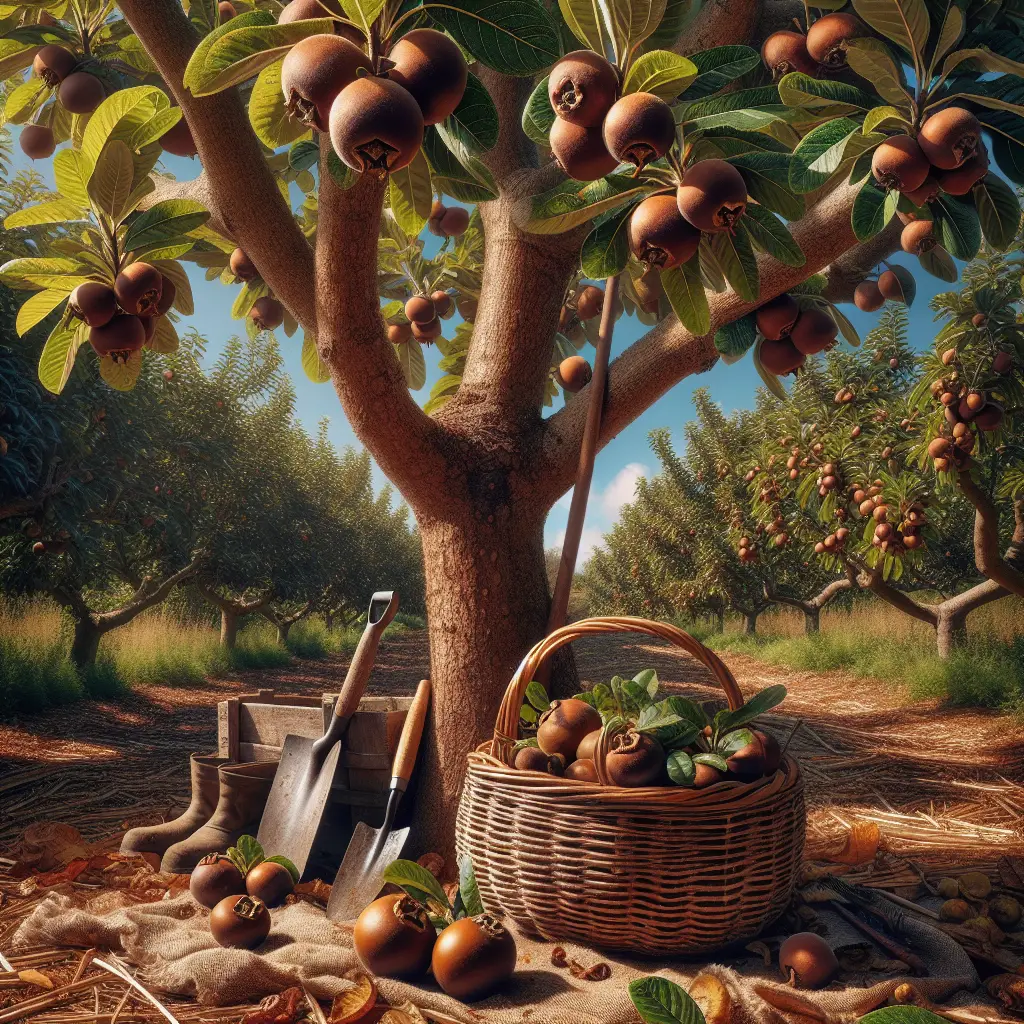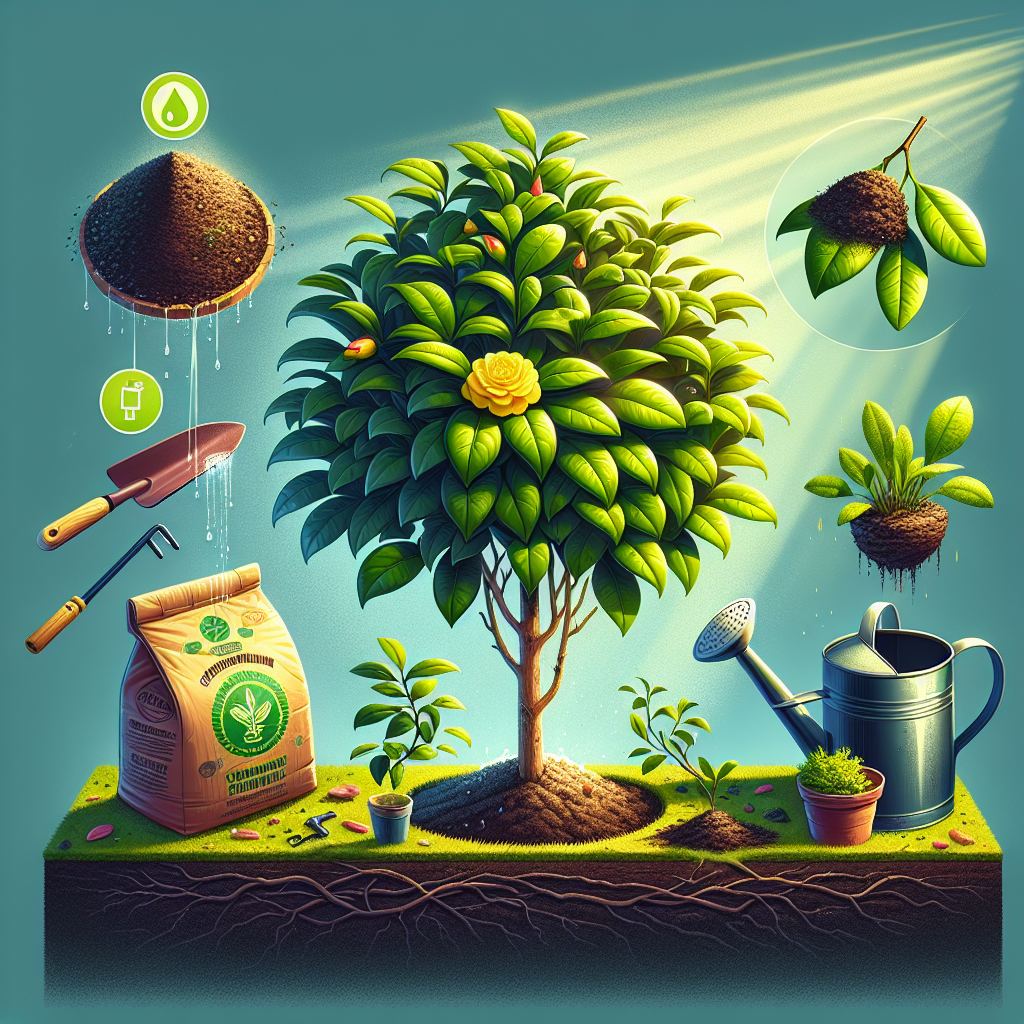Cultivating Medlar for a Unique Fruit Experience
Updated May 1, 2024 at 4:57 pm

An Overview of Medlar Cultivation
- Pet Friendly: Medlars are non-toxic, making them pet-friendly options for gardeners with furry companions.
- Light Requirements: Full sun is essential for a healthy medlar tree, so positioning them where they can soak up at least six hours of direct sunlight is optimal.
- Watering: Newly planted medlar trees require regular watering to establish roots. Once established, they are quite drought tolerant.
- Humidity: Medlars are adaptable to a range of humidity levels but prefer a drier climate to prevent disease.
- Temperature: They thrive best in moderate climates without extreme heat or cold. Frost can affect the fruit, so take precautions to protect the tree in colder regions.
- Difficulty: Medlar trees are relatively easy to grow for both novice and experienced gardeners, requiring minimal maintenance once established.
Choosing the Right Variety for Your Garden
When you’re getting into medlar cultivation, one of the first decisions you’ll face is the variety to plant. There’s the classic ‘Dutch’ medlar known for its large fruits and the ‘Nottingham’, which is smaller but reputed for its remarkable taste. Your choice might depend on whether you’ve got more of a sweet tooth or if you’re aiming for a bountiful harvest.
The beauty of medlars is their rarity in the modern fruit market, creating a niche for those interested in heirloom and unique fruits. There’s definitely a conversation starter in every medlar—one that speaks of history, cultivation challenges, and the reward of patience, as the fruit only reaches its best post-bioripening, known as bletting.
Planting and Site Selection
The site you choose for your medlar tree directly influences its health and fruit production. Look for a spot that’s protected from strong winds but sunny enough to allow your medlars to revel in the full glory of the sun, which bolsters fruit production. These trees also prefer well-draining soil, so an elevated or sloped area could work wonders.
Planting a medlar tree isn’t much different from other fruit trees. The best time to plant is during the dormant season—late fall to early spring. If you live in a colder climate, aim for early spring after the last frost to give your tree a good start.
Soil Requirements and Preparation
Medlars aren’t overly fussy about soil, which is great news for gardeners. However, for optimal growth and fruiting, aim for loamy, well-drained soil with a slightly acidic to neutral pH. A soil test could guide you in making any necessary amendments before planting. Adding organic matter like compost can improve the soil structure and nutrition.
To prepare the ground, dig a hole that’s generously spaced to accommodate the root system of your medlar tree, ensuring that the graft union remains above soil level. It’s crucial to keep the roots moist while you work, so avoid exposing them to air for too long.
Feeding and Mulching Your Medlar Tree
A balanced fertilizer applied in early spring can cater to your medlar tree’s nutritional needs, aiding in robust growth and better fruit yield. A slow-release formula works best as it provides a steady supply of nutrients.
Adding a layer of mulch around the base of your medlar tree is a sensible move. It helps retain moisture, keep the weeds at bay, and gradually enrich the soil as it breaks down. Organic mulches such as wood chips or composted leaves are best. Just remember to keep the mulch away from the trunk to prevent potential rotting.
Pruning for Health and Productivity
Pruning your medlar tree not only keeps it looking tidy, but it also prevents disease and encourages a more fruitful harvest. Winter, while the tree is dormant, is the best time for this task. Focus on removing any dead or diseased wood and opening up the canopy to allow light and air to penetrate its center.
To encourage fruiting spurs, prune your medlar in late winter or early spring. You’ll want to remove any branches growing inwards and thin out dense areas. If you’re unsure, it might be useful to reach out to a local nursery or an experienced gardener for pruning tips specific to medlars.
Watering: Striking the Right Balance
Watering your medlar tree appropriately is crucial, especially during its formative years. Ensure the soil is kept evenly moist but not waterlogged. Overwatering can lead to root diseases, while under-watering, especially during drought periods, can stress the tree and impact fruit set and quality.
Once established, medlar trees are somewhat drought-resistant. During these later stages, it’s more about monitoring the tree during extended periods of dry weather and watering it deeply but less frequently to encourage strong, deep root growth.
Harvesting and Enjoying Medlars
One unique aspect of medlars is their harvesting process. Fruits are picked in the late fall when they’re hard and not quite ripe. They undergo a process called bletting, where they’re stored in a cool, dark place until they become soft and brown, achieving a flavor described as a cross between applesauce and wine. It might be a challenge to wait, but the resulting taste is well worth it!
Medlars can be enjoyed fresh or in various culinary creations. Medlar jelly is a traditional delicacy that pairs wonderfully with meats and cheeses. For a festive treat, you might also try making medlar cheese or even adding them to pies and tarts for a twist on the usual fruit fillings.
Pest and Disease Management
Luckily, medlars are not particularly prone to many pests or diseases, but it is wise to keep an eye out for common issues such as fire blight and fruit flies. Regular inspection of your tree will help catch any problems early when they are most manageable.
For organic pest control, consider introducing beneficial insects like ladybugs or using neem oil as a deterrent. It’s best to avoid harsh chemicals, as they can upset the natural balance of your garden ecosystem and potentially harm the beneficial organisms that promote the health of your medlar tree.
Getting the Most Out of Your Medlar
With some patience and care, your medlar tree can be a long-lasting addition to your garden that provides not just unique fruits but also ornamental value. Given its attractive blossoms and interesting foliage, it can serve as a focal point for your garden space.
For those looking to extend their medlar experience, consider picking up a book that dives deep into the history and culinary uses of this ancient fruit. “The Book of Medlar” by Jane McMorland Hunter is a celebrated choice known for its engaging content and practical tips.
If you’re interested in trying medlar preserves, look for artisan brands like ‘The English Preserves Company,’ known for high-quality, handcrafted medlar jelly. It’s said that their diligent process of making the jelly captures the essence of medlars, and many reviews rave about their depth of flavor.
Find This and More on Amazon
Final Words: The Joys of Medlar Cultivation
Embracing the medlar tree in your garden is about accepting an invitation into an age-old tradition of fruit cultivation. It’s an endeavor that allows you to reconnect with gardening practices of the past while enjoying a fruit that many have forgotten. The medlar isn’t just a botanical oddity; it represents a lineage of horticultural heritage that you help keep alive.
Whether you are a dedicated gardener or an enthusiastic amateur, cultivating medlars promises a gratifying journey filled with discoveries, culinary adventures, and the simple joy of nurturing life from the earth. Here’s to your success with this unique and unforgettable fruit experience!
Understanding the Bletting Process
Bletting is a crucial phase in the medlar’s journey from tree to table. For those new to medlars, the idea of allowing fruit to soften to the point of spoilage goes against all conventional wisdom. Yet, in the case of medlars, this process transforms the initially hard and acidic fruits into a sweet, custard-like delicacy.
Consider setting aside a cool, dark space in your pantry or basement for bletting. The medlar fruits benefit from being laid out in single layers on a breathable surface. A touch of frost actually helps initiate bletting but beware, too much cold weather can damage the harvest, so monitor the temperatures carefully.
Landscaping with Medlar Trees
Aside from their fruit, medlar trees offer aesthetic appeal. In the spring, their white flowers are a magnet for pollinators, and they have a branching habit that provides natural shade. Some landscapers practice espalier—training the tree to grow flat against a wall for a living art installation.
Cultivating medlars isn’t just about filling your belly; it’s also about creating beauty in your yard. Their open canopy will not overpower a small garden, making them perfect for intimate landscapes. Come autumn, the leaves turn a gold that rivals the fruit dangling from the branches.
Companion Planting and Biodiversity
Companion planting is an age-old practice that promotes a healthy ecosystem. Planting flowers that attract beneficial insects close to your medlar tree, for example, can increase pollination and reduce the chance for pests.
Marigolds, lavender, or nasturtiums could serve as great companions. Their vivid flowers not only complement the understated beauty of medlar trees but also help build a rich, biodiverse environment where various species can thrive in harmony.
Troubleshooting Common Medlar Tree Issues
Though medlar trees are hardy, they’re not immune to challenges. Leaf curl and aphids are occasional issues that may arise. The trick is to catch these early and manage them organically if possible—neem oil sprays can be effective against aphids without damaging the local insect population.
Another issue could be fruit drop, often caused by irregular watering. Consistent care keeps the tree at its best. Should you notice anything abnormal, getting advice from local horticultural societies or extension services could offer insight into treating specific regional problems.
Medlar as a Cultural and Historical Curiosity
Diving into the history of medlars is like turning the pages of a forgotten chapter in botanical lore. This fruit has been cultivated since Roman times and was a medieval staple. Recipes and references to medlars can be found in historical texts, giving you a deeper understanding of their place in culinary heritage.
For a tangible connection to this history, try sourcing recipes that use medlar in traditional ways. Look for books on historical cooking or visit archives for culinary inspiration. Cooking with medlars provides an experience that’s as much about taste as it is about connecting with the past.
Conserving Water and Sustainability Practices
Water conservation is instrumental in sustainable gardening, particularly in areas prone to drought. For eco-conscious gardeners, using rain barrels to collect water for your medlar trees is an environmentally friendly choice. Additionally, consider drip irrigation to deliver water directly to the roots with minimal waste.
By adopting these sustainable methods, not only do you support your medlar tree’s growth, but you also contribute to the welfare of your local ecosystem. It’s practices like these that ensure gardening remains in harmony with the natural world.
Engaging with the Gardening Community
Sharing your love for medlars can expand your horizons and those of fellow gardeners. Joining gardening forums or local clubs allows you to exchange tips and perhaps even medlar cuttings. There’s a joy in connecting with other enthusiasts who appreciate the unique qualities of this fruit.
Remember, knowledge grows when shared. You might even start a local trend, encouraging a community of medlar lovers who can swap not just stories but also home-made medlar treats. Community gardens might also welcome the addition of a medlar tree, bringing a touch of history to public spaces.
Curating Your Own Medlar Orchard
If you find yourself enamored with these fruit-bearing trees, why not consider starting a small orchard? A medlar orchard can be a testament to biodiversity and a celebration of less common varieties of fruit. You’ll have ample opportunity to observe different trees’ habits and fruiting patterns.
Each tree can offer its own story and character. Plan your orchard layout with both ease of access and aesthetics in mind. Remember, medlars don’t need to be relegated to the background; they can stand proudly among the more common fruit trees with a charm all their own.
Conclusion and Content area 2 of 3
Whether you’ve been drawn to the medlar tree for its historical allure, its quirky fruiting habits, or its elegant appearance, it’s clear this is a tree with much to offer. The cultivation of medlars isn’t just about producing fruit. It’s about embracing a piece of history, sharing stories, and creating beauty in the garden.
So, if you’ve been considering adding something different to your garden, the medlar tree might just be the unique botanical experience you’re looking for. Happy gardening!
Exploring the Nutritional Benefits of Medlars
Now, beyond the undeniable charm and history that medlars bring to your garden, there’s more to these fruits than meets the eye. Nutritionally, medlars are a fascinating topic. They’re rich in vitamin C, dietary fibers, and contain small amounts of various essential nutrients.
This means that integrating medlars into your diet can aid in digestion and boost your immune system. Plus, they are a low-calorie fruit which makes them a smart addition for those watching their calorie intake. With its complex flavors, the medlar can turn a healthy snack into a gourmet experience.
Medlar Recipes Worth Trying
Getting the art of medlar cuisine right can be an adventure in its own right. From the classic medlar jelly to more contemporary recipes, there’s a wide range of ways to enjoy this eccentric fruit. Don’t be afraid to experiment and tweak recipes to suit your taste, as the medlar is versatile in the kitchen.
If your enthusiasm for medlars is piqued, seek out “Medlars in the Kitchen” by Annette Balfour-Lynn. This book is brimming with unique recipes, from simple medlar butter to elaborate dishes that showcase the fruit’s potential. According to culinary enthusiasts, Balfour-Lynn’s instructions are clear and the results delightful.
Find This and More on Amazon
Medlar Tree Varieties and Their Specifics
As you delve into cultivating medlar, you may become curious about the various strains available. Beyond the ‘Dutch’ and ‘Nottingham’, there’s the ‘Royal’, hailed for its fruit size and pleasant flavor, and the ‘Breda Giant,’ which is robust and bears consistently.
When choosing, consider your climate, as some varieties cope better with varying temperatures than others. Furthermore, some medlar varieties bloom earlier, which can make them vulnerable to late frosts. It’s worth reaching out to regional growers or agricultural extensions for advice tailored to your locale.
Storing and Preserving Your Medlar Harvest
After you’ve patiently bletted your medlars, it’s essential to know how to store and preserve them to enjoy their unique flavor for as long as possible. Fresh, bletted medlars should be consumed or processed within a few days, but there are several preserving techniques that can extend their shelf life.
Medlar fruit leather is a rustic, simple way to preserve the fruit while concentrating its flavor. Alternatively, medlar brandy is a more adventurous path, infusing spirits with the distinct profile of the bletted fruit. Either way, your medlars can provide enjoyment well beyond their harvest season.
Creating a Medlar-Friendly Ecosystem in Your Yard
Your approach to gardening can make a significant difference in how well your medlar tree flourishes. By fostering an ecosystem that supports its growth, you’re not just growing a tree; you’re cultivating an environment.
Incorporate plants that attract pollinators, set up habitats for beneficial predators, and even consider vermiculture to enrich the soil naturally. A diverse, thriving garden ecosystem supports your medlar tree and contributes to local biodiversity.
Medlar Tree Grafting and Propagation
As you become more comfortable with your medlar tree, you might contemplate propagation. Grafting is a common method, where a medlar scion is attached to a compatible rootstock. This not only preserves the characteristics of the variety but can also help the tree adapt to different soil conditions or climates.
Grafting workshops or classes can be a valuable resource if you’re new to the process. Don’t hesitate to reach out to orchardists or nursery experts who can demonstrate the technique and even recommend particular rootstock that thrives in your area.
Medlar Trees and Cultural Significance
It’s intriguing how a single tree can embody cultural importance. Medlars have been associated with love and patience due to their late fruiting. In literature and art, they’ve often been used as symbols, and some cultures consider them good luck.
Understanding these nuances adds another dimension to your gardening journey. Celebrating harvest with a medlar-themed event, or simply sharing this fruit’s story with friends, enriches the communal experience and honors the medlar’s legacy.
Looking Forward: The Future of Medlar Cultivation
As trends in gardening ebb and flow, medlars have the potential to regain their status as a celebrated fruit. With the increasing interest in heirloom varieties and sustainable, local food sources, medlars offer a chance to partake in a movement that values tradition, taste, and ecological awareness.
Your medlar cultivation could be part of a broader effort to preserve and proliferate diverse fruit varieties. It’s a chance to contribute to genetic variety in fruit crops, as well as to educate others on the importance of upholding our rich horticultural heritage.
The Enriching Journey of Medlar Cultivation
The journey of cultivating medlars is replete with novel experiences, tastes, and even friendships forged over a shared interest in this unique fruit. As you continue to tend to your medlar trees and savor their fruits, you are participating in a tradition that dates back centuries and spans many cultures.
Whether medlar cultivation is your pathway to a hobby, a passion for heirloom varieties, or a desire for sustainable gardening, it offers rewards that go beyond the garden. It’s a unique endeavor that promises to enrich your life with its flavors, stories, and experiences.
Shop more on Amazon

